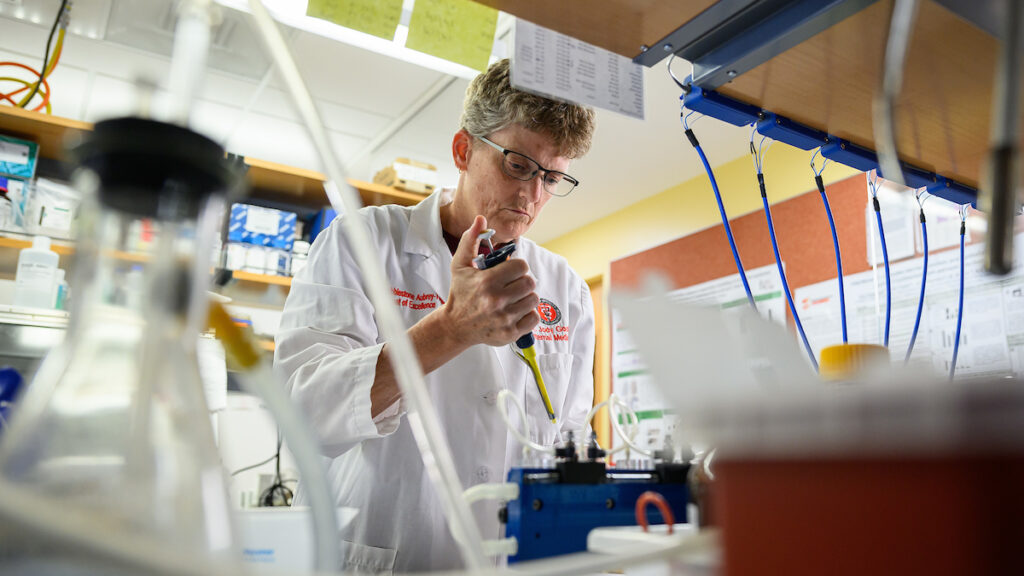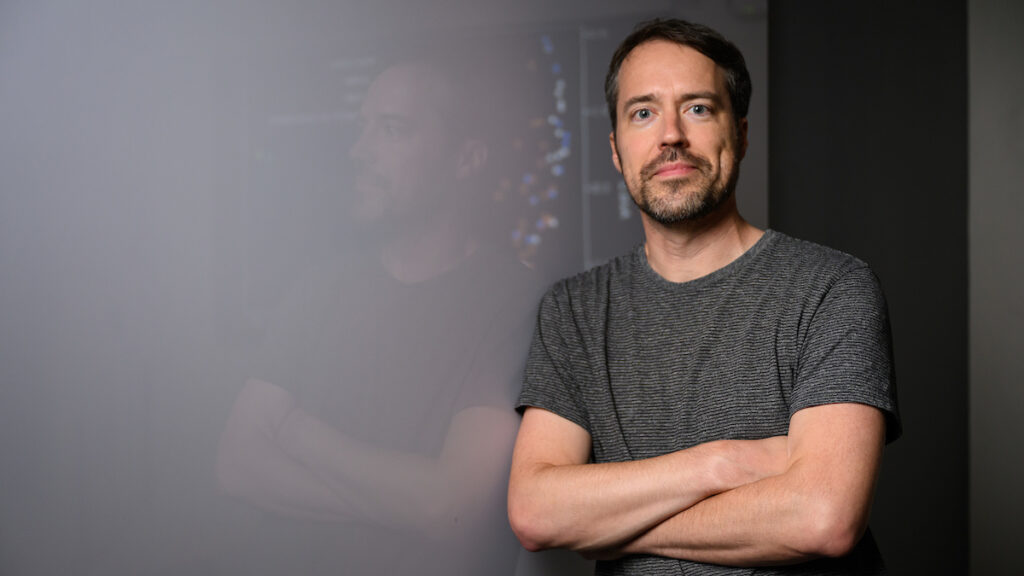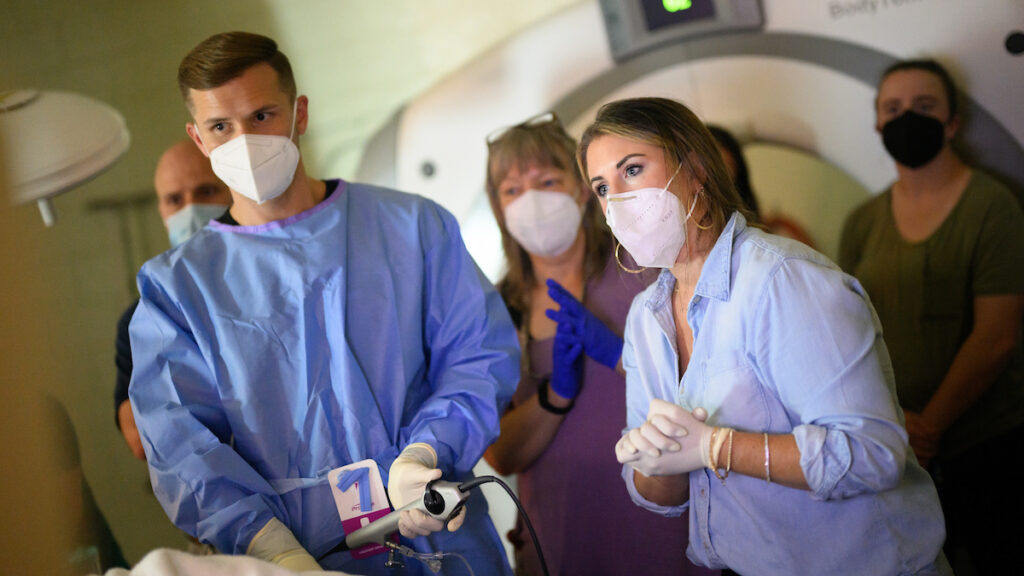Two veterinary internists at the NC State College of Veterinary Medicine have determined that a cat’s gallbladder doesn’t have its own microbiome, an important discovery for the treatment of feline cholangitis, the most common acquired inflammatory liver disease in domestic cats.
Without the expertise of Dr. Ben Callahan, who has a Ph.D. in physics, however, Dr. Jody Gookin and Dr. Tanner Slead could never have designed a study that showed conclusively that any infection-causing bacteria found in the bile of suffering cats came from somewhere else.
Microbiomes are communities of microscopic organisms, such as fungi, bacteria and viruses, that exist in a particular part of the body.
Callahan, a world-renowned expert in microbiomes, joined the NC State College of Veterinary Medicine’s Department of Population Health and Pathobiology in 2017 as part of a “cluster hire.” In 2011, NC State University announced a plan to add more than 75 faculty members in 20 select fields or “clusters” to enhance its interdisciplinary, solution-driven research and innovation.
“Ben was hired as part of the Chancellor’s Faculty Excellence Program, and one of the key goals was to place someone like Ben in an environment where he could collaborate with clinicians,” says Gookin, a professor of small animal internal medicine. “He is not in a silo somewhere else, and having the disciplines together like this creates magic.”
Callahan is an associate professor of microbiomes and complex microbial communities, which is one of those 20 interdisciplinary clusters that include bioinformatics, environmental health science and genetic engineering and society. About 15 of the veterinary college’s nearly 160 faculty members were part of universitywide cluster hires.
Gookin and Slead started working with Callahan on the feline microbiome study in 2020. Slead had entered a three-year residency program in small animal internal medicine at NC State after completing his DVM at Kansas State University. To become board-certified, veterinary residents also must plan and publish the results of a research project, and Slead and Gookin, his mentor, focused on cholangitis because it is common in cats and difficult to diagnose without a liver biopsy.

“Increasingly at NC State, though, we will use ultrasound to obtain a sample of bile from the gallbladder of cats in which infection is suspected and culture it,” Gookin says. “But cultures are rudimentary. We know now, with our understanding of microbiomes, there’s a lot of bacteria that won’t grow by standard ways we use in the lab, so when we don’t find anything, we wanted to know, are we actually missing anything?”
Culturing bile, which is produced by the liver but stored in the gallbladder, to find possible sources of infection requires researchers to choose what they want to test for, and tests don’t exist for every bacteria.
Studying microbiomes, on the other hand, relies on DNA sequencing, and scientists have now created a database of the DNA of millions of bacteria.
“In culturing, you’re basically trying to guess what species it is and putting it on a plate that selects for that, and seeing if that grows,” Callahan says. “But with the sequencing-based techniques, you don’t have to guess. You’ll just detect whatever bacteria is there.”
Callahan wrote, developed and published software that many other scientists use to identify bacteria from raw DNA sequencing data. Other scientists have cited his research on the Divisive Amplicon Denoising Algorithm 2, or DADA2, more than 10,000 times.
The challenge
When starting their gallbladder study, Gookin and Slead first needed to know whether the healthy gallbladder had bacteria living in it or whether it was a sterile environment. If the gallbladder had its own microbiome, some infections could be caused by an overgrowth of what’s normally healthy bacteria.
“No one had ever done this study before to look at whether there is a microbiome in cat bile,” Gookin says. “There are fairly few studies in humans.”
The challenge with looking for a microbiome in a place that likely has a low or no bacterial count is that the tests are very sensitive and will inevitably pick up contaminants when they can’t find anything else with DNA in the samples.
Fortunately, Callahan, winner of the 2023 American Society of Microbiologists’ Microbiome Data Prize, also is the person who wrote the software that scientists use to design microbiome tests that filter out contaminants.
About eight years ago, Callahan says, researchers purported to find a microbiome in the human placenta, which, like the gallbladder, was presumed to be a sterile environment. The initial conclusions of that study were largely debunked. Five years of scientific advancements and follow-up studies determined that the bacteria actually was from contaminants introduced through equipment used to collect the placental samples.
“Because of his expertise, Dr. Callahan was really able to teach Dr. Slead and me how to do this study,” Gookin says. “We would have completely misinterpreted the results if it wasn’t for his help in designing the study.”

Over the course of their work, the researchers were able to obtain bile from 43 feline patients at NC State Veterinary Hospital that were suspected of having an infection.
To control for contaminants, Callahan had the research team collect what were essentially fake samples as well. They used the same type of tubings and the same type of needles and syringes on the same piece of skin that they used to extract bile from the cats, but they didn’t extract bile. They filled the sample tubes with saline, and they ran the saline through the same analysis that they used for the bile.
“What that showed us was what a microbiome derived entirely from contamination looked like,” Gookin says. “All of a sudden, we got this fake microbiome out of this sample that didn’t even have any bile in it, so we knew all of this bacteria is junk. If we find it in our bile sample, we know it’s not real.”
The vast majority of bacteria their testing found was the same in both the bile and saline samples, meaning that the seemingly diverse microbiome detected by sequencing in most bile samples was from contaminants and the healthy gallbladder was indeed a sterile environment.
However, in a small subset of samples, microscopy detected infiltrating bacteria, culture detected the presence of E. coli and sequencing detected large numbers of bacteria not present in the saline controls. Bile can get infected, and all three methods ultimately agreed on the infected bile samples, Callahan says.
“People don’t really realize this happens,” Gookin says. “There are a number of papers that are published looking at supposedly sterile sites for presence of a microbiome, like the placenta example and our bile example and the urinary bladder, things like that, where people don’t understand the impact of contamination and publish these papers saying, “Look at this microbiome in this site,” and in fact it’s simply background contamination.”
‘Cutting-edge work’ for cats
For cats, Slead says, the study results mean that clinicians can more accurately diagnose and understand the role of bacteria in liver diseases and that they can consider bile culture an adequate diagnostic tool when looking for the most common infections, such as E. coli.
“It’s really accurate,” says Slead, now a veterinary internist in Texas. “We are not missing any novel, unique, unculturable bacteria in the bile of these cats. Since we know bile is sterile, when there is an infection there, it means it’s probably coming from another organ like the gut. Then we also found, when there’s a negative culture, we can probably believe that.”

The study, published online last month at Pub Med, had several other authors: pathologist Megan Schreeg, who examined 17 control cats; radiologist Gabriela Seiler, who interpreted ultrasound images from all the cats; clinical pathologist Devorah Stowe, who performed a microscopic examination of the bile samples; microbiologist Megan Jacob, who cultured the bile samples; and M. Andrea Azcarate-Peril, director of the Microbiome Core Facility, which is part of an NIH-funded Center for Gastrointestinal Biology and Disease that NC State and UNC-Chapel Hill share.
“This was a whole, across-the-board collaborative success,” Gookin says. “Ben’s expertise, my clinical problem, training a resident to become board-certified, and these were samples from clinical patients, bile samples we collected from cats we thought had the disease. Just cutting-edge work done in a cutting-edge way to generate new knowledge.”
For Callahan, the gallbladder study gave him additional experience and confidence about how to help other clinicians design and conduct similar studies. This study had all of the right negative controls and enough of them, he says, in addition to providing a robust clinical investigation in terms of both looking for bacteria in the bile under a microscope and culturing the bile for bacteria.
“When you have those three different measurement types – the culture, microscopy and sequencing – plus the negative controls to interpret the sequencing, you can put them all together and in the end what could have been a very confusing picture was in fact a very clear picture,” he says. “All three measurement types agreed, completely, about which samples actually had bacteria.”
Callahan also notes that this was the first project with veterinary clinicians that he was in on from the beginning and helped design.
“It turned out so lovely,” Callahan says. “I really enjoy that, in my cold, mathematical heart. The cats are nice, but the data was really clean.”